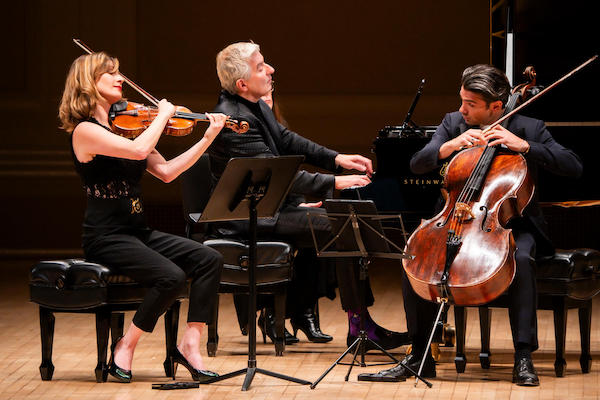All-star trio achieves liftoff with Thibaudet, Batiashvili, Capuçon at Carnegie

Carnegie Hall, or at least its spacious Isaac Stern Auditorium, is not always the most hospitable chamber to hear chamber music in. The genre’s intimate exchanges can get lost in its vast expanse.
Stern himself, a violinist accustomed to commanding large spaces, used to make it work with his Istomin-Stern-Rose Trio, a vigorous ensemble of acclaimed solo artists. And so did another such all-star group on Tuesday night, as pianist Jean-Yves Thibaudet, violinist Lisa Batiashvili, and cellist Gautier Capuçon lit Carnegie up with a brilliant program of trios by Haydn, Ravel, and Mendelssohn.
The players’ individual virtues were very much on display: Thibaudet’s jaw-dropping digital facility, Batiashvili’s ripe and soaring lines, Capuçon’s bold and creamy tone. But one sensed no clash of egos; years of playing together and the group’s present coast-to-coast tour apparently took care of any potential star-tripping. What one heard was mutual determination to wring every drop of musical expression from these extroverted works.
The opening Haydn Trio in E major, Hob. XV: 28, was the sole piece where one was unsure the players were all on the same page. Composing his more than two dozen piano trios chiefly for amateur players, Haydn transformed a sleepy domestic genre not so much with technical dazzle as with his acute intelligence and wit.
The piano plays the lead role in all these works, and on Tuesday Thibaudet led off with rather fussy, rococo inflections, playing “on top of the keys” as pianists say, while his partners, when they got the chance, tended to dig in and drive the composer’s ideas forward.
The second movement, an outwardly simple Allegretto with a florid right-hand melody over a steady “walking” bass in the left, took an unexpected turn when the string players took over and inverted the texture, with the violin doing the walking and the cello singing the melody down below.
In the finale, with its jaunty theme, one felt again the contrast between the string players’ firm attack and the pianist’s relatively tentative touch. But Haydn’s witty dialogue eventually carried the day.
Happily, the soft piano chords that opened Ravel’s Piano Trio had a firm core and a sense of direction, and it soon became clear that this threesome would hold nothing back as they explored this composer’s rich variety of colors and sonorities. Batiashvili’s violin was especially impressive for its tonal range, a silver thread one minute and a robust contralto the next.
The scherzo-like Pantoum began soft and scintillating, then burst into a conflagration that showcased the virtuoso technique of all, especially Thibaudet. In contrast, the dark-hued passacaglia, marked Très large (very broad) climbed up steadily from the piano’s depths in a series of ever-grander variations, the strings playing in well-tuned unison two octaves apart, a characteristic Ravelian sound.
In the finale, the piano tone was light without thinness in the fleet opening bars, and massive without banging in fortissimo moments later on. Rapid string-crossing figures from violin and cello added atmosphere at first, then excitement as the music built. The piece’s spectacular finish, followed by an ovation, left one wondering what the elegant Mendelssohn could do to follow such an onslaught.
One needn’t have worried. The great pianist-composer wrote his Piano Trio in C minor, Op. 66, to dazzle, and dazzle it did on Tuesday. Thibaudet artfully shaped the blizzard of notes in his part, seemingly without effort, while the strings held the line taut in passionate phrases. Capuçon’s cello powerfully reinforced the bass line, then stepped up with the movement’s vibrant second theme. The ensemble expertly managed the music’s ebb and flow, leading to a final flash of piano octaves and strings climbing to the slam-bang conclusion, causing a few audience members to forget themselves and (gasp) clap between movements.
There was a cool elegance to Thibaudet’s shaping of the rocking chordal melody in the Andante espressivo, but then the strings made it sigh and swoon. The more flowing second theme was sonorous in its rise, sweet in its descent to the pianissimo close. In the Scherzo, fleet piano and skittering strings captured the inimitable Mendelssohnian style while sustaining the movement’s long line and direction.
A leaping theme launched the Allegro appassionato, which the players took at daringly high speed with not a bow hair out of place, shaping the music handsomely and dialing the mood from tender to exuberant. Another characteristic touch, a chorale-style second theme for piano, was tenderly shaped at its return in the violin, and later boomed forth right before the thrilling rush to the close.
The musicians acknowledged the standing ovation with smiles and bows, and, these being Europeans, no cheek onstage went unkissed.
After several returns to the stage, the group treated the audience to an exuberant encore, the finale of Dvořák’s “Dumky” Trio, Op. 90.
Carnegie Hall presents Quartetto di Cremona in works by Wolf, Ravel, and Beethoven 7:30 p.m. Thursday in Weill Recital Hall. carnegiehall.org